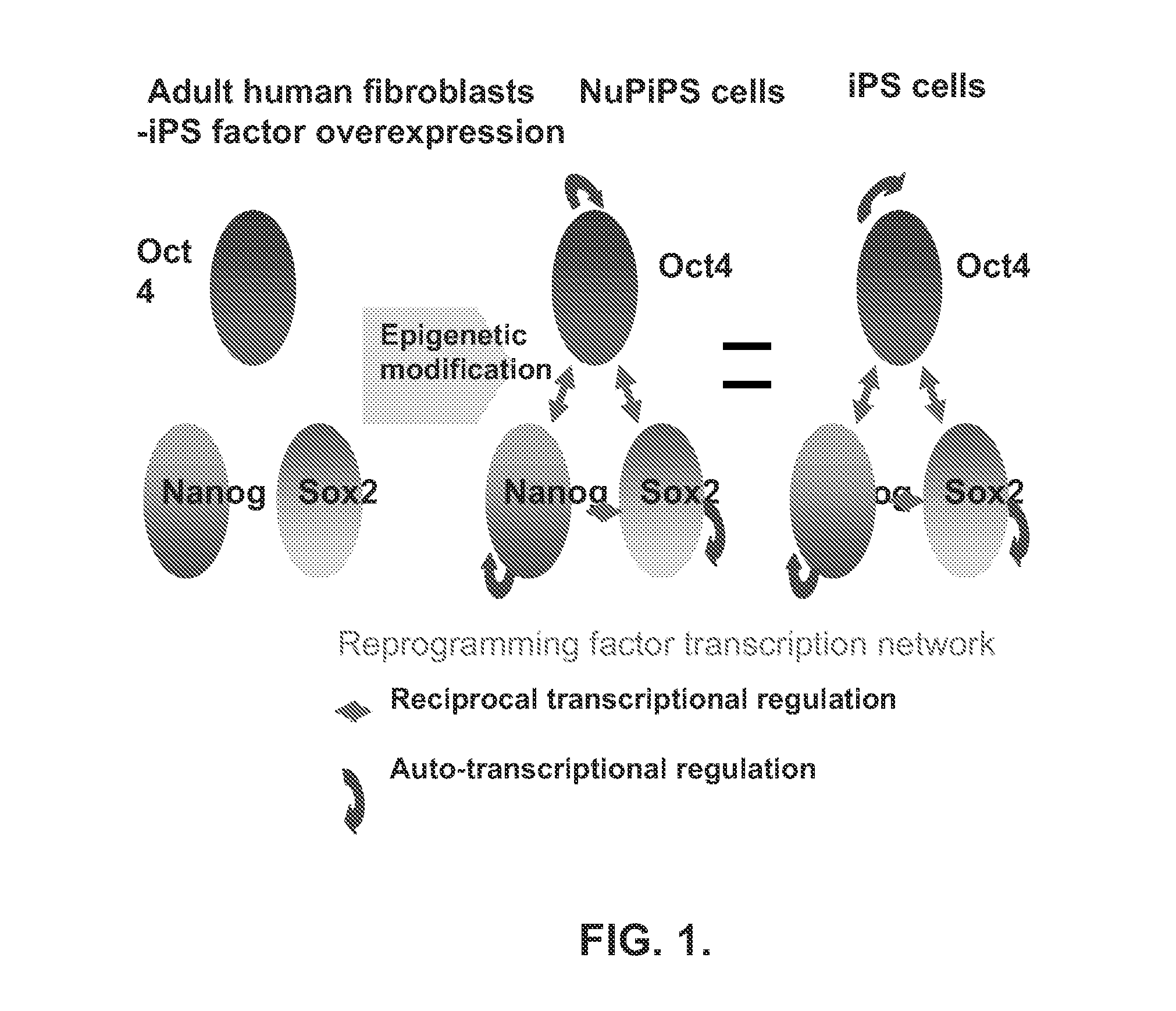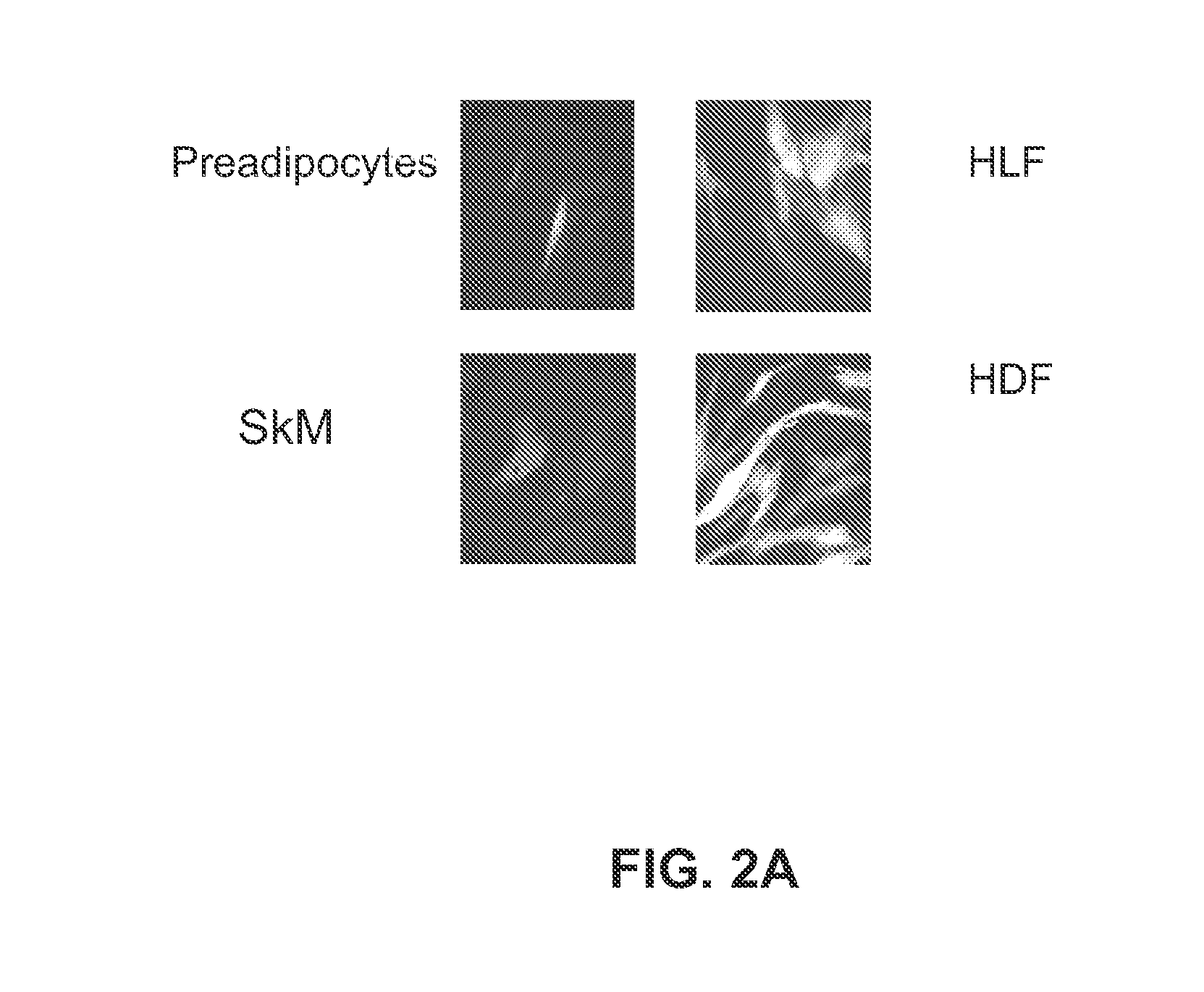Reprogramming a cell by activation of the endogenous transcription factor network
- Summary
- Abstract
- Description
- Claims
- Application Information
AI Technical Summary
Benefits of technology
Problems solved by technology
Method used
Image
Examples
example 1
[0187]RNA interference through siRNA or recently developed shRNA provides specific gene knockdown in vitro and in vivo. However, the efficiency of gene silencing is dependent on the delivery system and host cell tropism. The use of a retroviral or lentiviral vector dramatically enhances efficiency of transfection into a wide range of mammalian cell types in culture compared to traditional chemical delivery systems. Furthermore, additional selection and visualization is possible by adding antibiotic resistance genes and GFP, respectively, to the viral vector. In this example, we explored the transfection efficiency for different cell types.
[0188]Methods
[0189]Cell Culture.
[0190]Human dermal fibroblasts or human dermal fibroblasts harboring an Oct4-GFP reporter, were maintained at 37° C. in 95% humidity and 5% CO2 in Dulbecco's modified eagle medium (DMEM, Cell Application) containing 10% fetal bovine serum, 0.5% penicillin and streptomycin and additional zeocin (25 μg / ml) or puromycin...
example 2
[0197]Epigenetic components including DNMTs and histone deacetylases (HDACs) play an important role in regulating transcription of development-related genes as well as reprogramming of somatic cells. As HDFs exhibited efficient lentiviral transfection efficiency (see FIG. 2A), we tested the effects of shRNA-induced knockdown of DNMT1 and HDAC on pluripotency gene expression in this cell type.
[0198]Methods
[0199]Cell Culture.
[0200]Human dermal fibroblasts or, human dermal fibroblasts harboring an Oct4-GFP reporter, were maintained at 37° C. in 95% humidity and 5% CO2 in Dulbecco's modified eagle medium (DMEM, Cell Application) containing 10% fetal bovine serum, 0.5% penicillin and streptomycin and additional zeocin (25 μg / ml) or puromycin (2 μg / ml) as needed for the selection. Cells were grown, trypsinized and counted, then diluted in the above standard growth medium to achieve appropriate plating density prior to introduction of shRNA or transcription factor lentivirus.
[0201]Lentivir...
example 3
[0207]The effects of HDAC7 and HDAC 11 shRNA lentiviral infection on expression of pluripotency genes and other HDACs were tested. The effects of a histone deacetylase inhibitor (VPA) were also examined.
[0208]Methods
[0209]Cell Culture.
[0210]Human dermal fibroblasts or, human dermal fibroblasts harboring an Oct4-GFP reporter, were maintained at 37° C. in 95% humidity and 5% CO2 in Dulbecco's modified eagle medium (DMEM, Cell Application) containing 10% fetal bovine serum, 0.5% penicillin and streptomycin and additional zeocin (25 ug / ml) or puromycin (2 ug / ml) as needed for the selection. Cells were grown, trypsinized and counted, then diluted in the above standard growth medium to achieve appropriate plating density prior to introduction of shRNA or transcription factor lentivirus.
[0211]Lentivirus Infection.
[0212]High tittered SMARTvector™ shRNA lentivirus (≧108 Transfection Unit / ml) for epigenetic modification was obtained from Dharmacon (Thermo Fisher Scientific, www.dharmacon.com)...
PUM
| Property | Measurement | Unit |
|---|---|---|
| Fraction | aaaaa | aaaaa |
| Time | aaaaa | aaaaa |
| Digital information | aaaaa | aaaaa |
Abstract
Description
Claims
Application Information
 Login to View More
Login to View More - R&D
- Intellectual Property
- Life Sciences
- Materials
- Tech Scout
- Unparalleled Data Quality
- Higher Quality Content
- 60% Fewer Hallucinations
Browse by: Latest US Patents, China's latest patents, Technical Efficacy Thesaurus, Application Domain, Technology Topic, Popular Technical Reports.
© 2025 PatSnap. All rights reserved.Legal|Privacy policy|Modern Slavery Act Transparency Statement|Sitemap|About US| Contact US: help@patsnap.com



